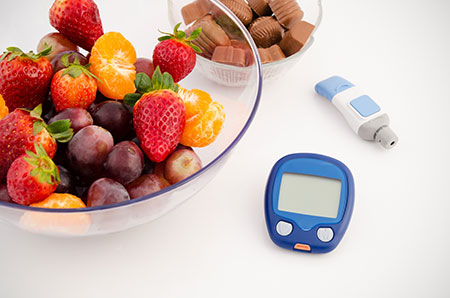What is type 2 diabetes?
Everyone’s blood has some glucose (sugar) in it. Your body needs glucose for energy. Normally, your body breaks food down into glucose and sends it into your blood. Insulin, a hormone made by your pancreas, helps glucose go from the blood into the cells so it can be used for energy.
If you have type 2 diabetes, your body doesn’t not use insulin properly. This is called insulin resistance. At first, your pancreas makes extra insulin to compensate for it. But, over time it isn’t able to keep up and can’t make enough insulin to keep your blood glucose at normal levels.
How can type 2 diabetes affect me?
Type 2 diabetes can lead to other problems like heart disease, stroke, nerve damage, and kidney or eye problems. But the good news is that keeping blood glucose, blood pressure, and cholesterol at target can help prevent or delay problems.

How is type 2 diabetes managed?
Most of the daily care of diabetes is up to you.Your plan for taking care of your diabetes includes:
- Choosing what, how much, and when to eat;
- Maintaining a healthy weight;
- Including physical activity everyday;
- Taking medicines (if needed) to help you reach your blood glucose, blood pressure, and cholesterol goals.
What can I do to take care of my diabetes?
- Lose weight, if needed.
- Should get to the goals for your diabetes ABCs:
- A: A1C (average blood glucose)
- B: blood pressure
- C: cholesterol.
- Work with your health care team.
- Make a plan that helps you reach your goals.
- Keep track of your numbers.
- If you’re not reaching your goals, change your plan to stay on track. Ask your health care provider for tools that can help you log your numbers.
Your blood glucose
American Diabetes Association targets are listed below. Your goals may be different. Talk with your health care team about the best goals for you. You’ll check your own blood glucose using a blood glucose meter. The meter tells you what your blood glucose is at that moment.
| Blood glucose targets | My usual results | My goals |
| Before meals: 70 to 130 mg/dL | ______ to ______ | ______ to ______ |
| 2 hours after the start of a meal: below 180 mg/dL | below ______ | below ______ |
Have an A1C test at least twice a year. It tells you your average blood glucose for the past 2 to 3 months.
| A1C targets | My last result | My goal |
| A1C: below 7% |
Your blood pressure
You should have your blood pressure checked at every consultation.
| Target | My last result | My goal |
| Below 140/90 mmHg |
Your blood fats
Your health care team should check your blood fat levels every year.
| Type of blood fat | Target | My last result | My goal |
| LDL cholesterol | Below 100 mg/dL | ||
| HDL cholesterol | Above 40 mg/dL (for men) | ||
| Above 50 mg/dL (for women) | |||
| Triglycerides | Below 150 mg/dL |
What do I need to know about healthy eating, physical activity, and medicines?
Healthy eating
Many people think that having diabetes means you can’t eat your favorite foods. But you can still eat the foods you like. It’s the amount that counts. Ask for a referral to a dietitian. Together, you’ll design a personal meal plan that can help you reach your goals. These steps can help you manage your diabetes:

- Count carbohydrates (also called carbs): carbs—bread, tortillas, rice, crackers, cereal, fruit, juice, milk, yogurt, potatoes, corn, peas, sweets—raise your blood glucose levels the most. Keep the amount of carbs in your meals and snacks about the same from day to day to help you reach your blood glucose targets;
- Choose foods low in saturated fat: cut down on foods with saturated fat to help you lower your cholesterol and prevent heart disease. Foods high in saturated fat include meats, butter, whole milk, cream, cheese, lard, shortening, many baked goods, and tropical oils such as palm and coconut oil;
- Lower portion sizes: cutting back on food portions at meals and snacks can help with weight loss;
- Eat more fiber: eat more high-fiber foods such as fruits, vegetables, dried beans and peas, oatmeal, and whole grain breads and cereals.
Physical Activity
Regular physical activity helps lower your blood glucose, blood pressure, and cholesterol. It also keeps your joints flexible, strengthens your heart and bones, and tones your muscles. Physical activity can also help lower stress. Your health care team can help you plan what activities are best for you. Try to include:
- Being active throughout the day: gardening, taking the stairs instead of the elevator, or walking around while you talk on the phone or watch TV. Work up to about 30 minutes each day;
- Aerobic exercise:brisk walking, dancing, rowing, swimming, or riding a bicycle. Work up to about 30 minutes a day, 5 days a week;
- Strength training: lifting light weights a few times a week.
Medicines
Some people with diabetes can manage their diabetes with healthy eating and exercise. However, your doctor may need to also give you diabetes pills and/or insulin to help you meet your target blood glucose levels.
Diabetes is a progressive disease—even if you don’t need to treat your diabetes with diabetes pills at first, you may need to over time. If it’s difficult for you to reach your target numbers, talk with your health care team about whether changes to your treatment plan can help.

This information is for education purposes and is not intended to replace a consultation with specialist doctor. If you have questions concerning your health condition, please discuss them with your doctor.



